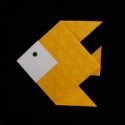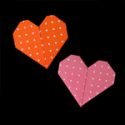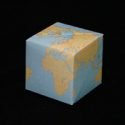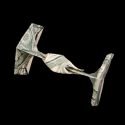Complete Origami
by David Mitchell


Complete Origami by David Michell starts with the traditional Samurai Helmet, the “Kabuto”. This is an example of pure origami where only valley and mountain folds are used; every fold is exact, defined, and has a function in the final model.

“Cormorant on a Rock” introduces the reader to reverse folds and the concept of dual subjects (the bird and the rock). Very elegant model and not too hard to fold.
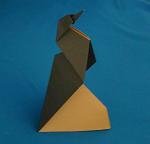

“Clingons” can hang onto one another; they demonstrate the versatility of the bird base since they look more human than bird.

Pull-out-squash is also used when converting the crane to a flying crane.
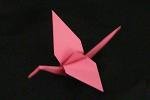

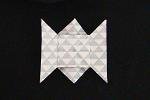
The “Tato” (folding purse) uses a root 5 geometry which is uncommon in traditional origami.
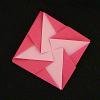
“Give Me Sunshine” is a geometric, bas-relief model representing the sun. The model is made by creasing the paper completely and then collapsing it to the proper shape: a crease-and-collapse design.
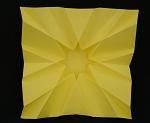
Shipwreck is an example of multi-piece origami. This type of origami is often seen in larger displays where many different models contribute to the general theme of the piece. Shipwreck uses the 60 degree folding geometry (equilateral triangle). Although not a butterfly or a bird, this is a sample of representational origami – a ship sinking!
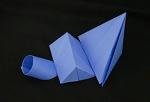
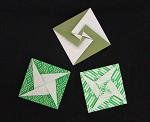
“Artifact” is a polyhedron made from six sheets of paper each folded in the same way. The six sheets are assembled into 3 rings. Interestingly, the 3 rings are not connected to one another but are interlocked. The concept of silver rectangles is introduced. This is the first “advanced” model in this book.
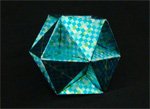

“Love Bird” appears as a bird, but when placed in front of a light, a heart is visible. This is an example of translucency. What appears to be a rather simple bird is actually a clever design which allows for the translucency of the paper to give the model an added level of depth.
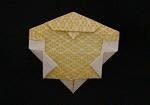
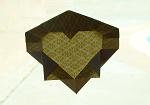
“David’s Star” is a crease-and-collapse design. Here a single sheet of paper is made into a stack of six-pointed stars (Star of David). Model is easy to fold, but collapsing it will take a bit of courage for the uninitiated. The concept of bronze-sized paper in introduced. Bronze rectangles are useful in that they easily form 60 degree angles.
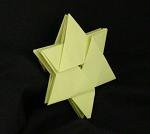
At first glance, this “Enigma Bowl” may appear quite plain, however, upon closer examination, you will notice some interesting features. The rim of the bowl is a 8-pointed star, the hole is in the shape of an octagonal, and the base of the bowl is a square. It is made from a complex base unlike those found in traditional origami.
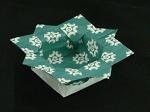
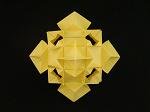
“Windfarm” an example of flat origami tessellation. It is folded from one sheet of paper though, slits are made to facilitate the folding process. Cutting a large sheet of paper to get smaller but still connected sections is called sub-dividing and it is used in Senzaburu Orikata, the first published origami instructions. (Note that “Rokoan” is a branch of origami where a large sheet is subdivided and each subdivision is folded into a crane. This creates a series of interconnected cranes.)
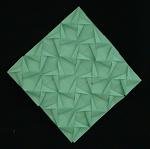
“Stargate” is an example of a macro-modular sculptures. It is a ring made with 5 Artifacts and 5 joining pieces. Note the size of Artifact adjacent to Stargate.
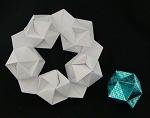
Summary
Although Complete Origami by David Mitchell is not complete, it is still a very comprehensive and satisfying origami book. I recommend this book for people who want to go beyond birds, frogs, and boats. The reader will increase their skill level with the crease-and-collapse designs, tessellations, and curved paper. Mitchell is very knowledgeable and imparts a wealth of information regarding origami and mathematics.
- buy Complete Origami
here
- see more book reviews
- go to Home Page
- go to Site Map
-
Books with Easy Origami
- Easy Origami: over 30 simple projects by John Montroll
- Origami Fun Kit for Beginners by John Montroll
- My First Origami Kit by Joel Stern
- Easy Origami: A Step-by-Step Guide for Kids by C Alexander & M Meinking
- Fun With Easy Origami (Dover Origami Papercraft)
- Origami: A Step-by-Step Introduction to the Art of Paper Folding by T Cook & S Henry
- Easy Origami For Kids Book Traditional Japanese Folding Papers Overs 20 Projects by J Wish
- Easy Origami for Kids: Over 40 Simple Origami Projects by O Brooks
Please Help
Please help by reporting broken links so that we can fix them. One easy message from you can save us hours and hours of clicking. Thanks!
-
More Origami Diagrams and Instructions…
-
These free origami instructions are made available to you by the paper folding community at large. If you have a diagram you would like to share, or if your diagram is listed here and you wish to have it removed, please Contact Us. Diagrams are intended for personal use. Copyright of the models lie with the origami creators and designers. Please contact the designer and/or creator directly for non-private usage of a model and/or artwork.









